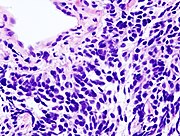Classification of lung cancer
| Histological type | Frequency (%) |
|---|---|
| Non-small cell lung carcinoma | 80.4 |
| Small cell lung carcinoma | 16.8 |
| Carcinoid[17] | 0.8 |
| Sarcoma[18] | 0.1 |
| Unspecified lung cancer | 1.9 |
The vast majority of lung cancers are carcinomas—malignancies that arise from epithelial cells. There are two main types of lung carcinoma, categorized by the size and appearance of the malignant cells seen by a histopathologist under a microscope: non-small cell (80.4%) and small-cell (16.8%) lung carcinoma.[16] This classification, based on histological criteria, has important implications for clinical management and prognosis of the disease.
Non-small cell lung carcinoma (NSCLC)
The non-small cell lung carcinomas are grouped together because their prognosis and management are similar. There are three main sub-types: squamous cell lung carcinoma, adenocarcinoma, and large cell lung carcinoma.
| Histological sub-type | Frequency of non-small cell lung cancers (%) | ||
|---|---|---|---|
| Smokers | Never-smokers | ||
| Squamous cell lung carcinoma | 42 | 33 | |
| Adenocarcinoma | Adenocarcinoma (not otherwise specified) | 39 | 35 |
| Bronchioloalveolar carcinoma | 4 | 10 | |
| Carcinoid | 7 | 16 | |
| Other | 8 | 6 | |
Accounting for 31.2% of lung cancers,[16] squamous cell lung carcinoma usually starts near a central bronchus. Cavitation and necrosis within the center of the cancer is a common finding. Well-differentiated squamous cell lung cancers often grow more slowly than other cancer types.[5]
Adenocarcinoma accounts for 29.4% of lung cancers.[16] It usually originates in peripheral lung tissue. Most cases of adenocarcinoma are associated with smoking; however, among people who have never smoked ("never-smokers"), adenocarcinoma is the most common form of lung cancer.[20] A subtype of adenocarcinoma, the bronchioloalveolar carcinoma, is more common in female never-smokers, and may have different responses to treatment.[21]
Small cell lung carcinoma (SCLC)
Small cell lung carcinoma (SCLC, also called "oat cell carcinoma") is less common. It tends to arise in the larger airways (primary and secondary bronchi) and grows rapidly, becoming quite large.[22] The "oat" cell contains dense neurosecretory granules (vesicles containing neuroendocrine hormones), which give this an endocrine/paraneoplastic syndrome association.[23] While initially more sensitive to chemotherapy, it ultimately carries a worse prognosis and is often metastatic at presentation. Small cell lung cancers are divided into limited stage and extensive stage disease. This type of lung cancer is strongly associated with smoking.[24]
Metastatic cancers
The lung is a common place for metastasis from tumors in other parts of the body. These cancers are identified by the site of origin; thus, a breast cancer metastasis to the lung is still known as breast cancer. They often have a characteristic round appearance on chest x-ray.[25] Primary lung cancers themselves most commonly metastasize to the adrenal glands, liver, brain, and bone.[5]
Staging
- See also: lung cancer staging with EUS
Lung cancer staging is an assessment of the degree of spread of the cancer from its original source. It is an important factor affecting the prognosis and potential treatment of lung cancer. Non-small cell lung carcinoma is staged from IA ("one A"; best prognosis) to IV ("four"; worst prognosis).[26] Small cell lung carcinoma is classified as limited stage if it is confined to one half of the chest and within the scope of a single radiotherapy field; otherwise, it is extensive stage.[22]



0 Comments:
Post a Comment
Subscribe to Post Comments [Atom]
<< Home